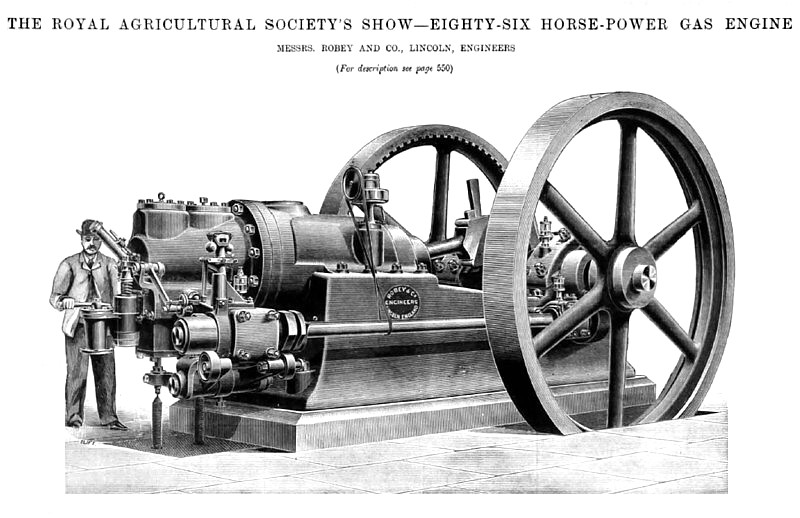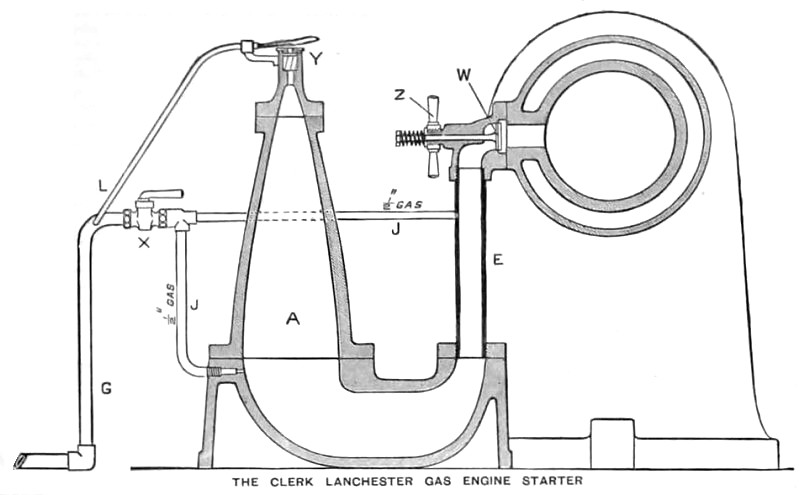|
Title: |
1893 Article-Robey & Co. Ltd., 86 H. P. Gas Engine |
|
Source: |
The Engineer Magazine, 23 Jun 1893 pg. 544 & 550 |
|
Insert Date: |
3/20/2013 12:39:21 PM |
Messrs. Robey and Co. exhibit some of their gas engines, one of the smaller sizes of which we illustrated some time ago, but as a fine example of the engines of their construction we give the illustration on page 544, of one of their engines as made in different sizes to give from 36 to 86 effective horse-power. They are on the four-cycle principle, and every part is well proportioned and of great strength. They a run at 160 revolutions per minute, and the 86-horse engine weighs 18.5 tons.
Messrs. Robey and Co. also exhibit Bell Richardson and Norris's oil engine in the portable and fixed forms. These are also so very nearly the same in general features as described by us last year, that we need not further describe them and being without information as to the performance of the engine, we have nothing to add to that which has already been said. Since the engine was exhibited at Warwick some modifications have been made. A jacket has, it is said, been added, but the water-tank to supply is the same as before the addition. Our informant on the Show ground did not enter into details. He may have meant that the jacket was extended, or altered as to circulation; perhaps this was necessary, but if there was previously no jacket, the water tank was presumably only to give the engine a “ portable " appearance.
For starting their gas engines, Messrs. Robey and Co. use the Lanchester starter, which we described last year, but they also now use the Clerk-Lanchester starter, which we illustrate above. It consists of a chamber A, outside and separate from the engine, and of a. capacity rather greater than that of the cylinder, with which it is connected by a pipe E, and check valve W. The crank being set at about 15 degrees, gas is turned on by a tap X, from the gas main G, and it flows into the chamber by the pipe J, mingling with the air therein and forming an explosive mixture. At the same time gas flows into the cylinder by the pipe shown. When the mixture is so far formed as to be flammable it lights at the jet Y, and a little later becomes of sufficient explosive strength. The tap X is then closed, and the ejecting pressure ceasing, the flame at Y shoots back, ignites the gaseous mixture in the chamber, and this forces the gas in E into the cylinder under a pressure of about 50 lbs. per square inch, and forms there a compressed mixture which, on ignition, gives an average pressure in the cylinder of about 85 lbs. per square inch, and starts the engine and its load.
Image courtesy of Grace's Guide.
http://www.gracesguide.co.uk/File:Im1893EnV75-p544a.jpg |
|
 1893 Robey & Co. Ltd., 86 H. P. Gas Engine
1893 Robey & Co. Ltd., 86 H. P. Gas Engine
 1893 Robey & Co. Ltd., 86 H. P. Gas Engine Starter
1893 Robey & Co. Ltd., 86 H. P. Gas Engine Starter
|
|